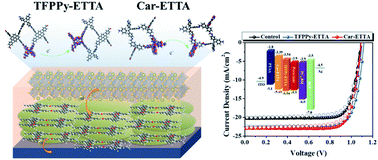Exploitation of two-dimensional conjugated covalent organic frameworks based on tetraphenylethylene with bicarbazole and pyrene units and applications in perovskite solar cells†
Abstract
In this work, two-dimensional conjugated covalent organic frameworks (2D-COF) based on a building block of tetraphenylethylene are successfully developed. Bicarbazole and pyrene moieties are respectively coupled with 4,4′,4′′,4′′′-(ethane-1,1,2,2-tetrayl)tetranilino (ETTA) via [4 + 4] solvothermal condensation conditions of 3,3′,6,6′-tetraformyl-9,9′-bicarbazole (Car-4CHO) and 1,3,6,8-tetrakis(4-formylphenyl)pyrene (TFPPy) to afford Car-ETTA and TFPPy-ETTA COFs. According to thermogravimetric analysis (TGA), powder X-ray diffraction (PXRD), and N2 adsorption and desorption measurements, both Car-ETTA and TFPPy-ETTA COFs exhibit excellent thermal stability, highly crystalline structure, and high specific surface area, respectively. These findings are supported by force field and ab initio calculations. Furthermore, successful applications of these COFs in perovskite solar cells (PVSCs) are demonstrated owing to their well-conjugated properties and π–π interactions. While serving as interlayers in the devices, these COFs could effectively promote the interfacial charge dynamic to further optimize the resulting performance. Besides, certain interaction between COFs and perovskite also leads to an improved morphology and crystallinity of the perovskite layer, presenting defect passivation capability. As a result, we show that the performance of the COF-modified PVSC could be improved from 17.40 to 19.80%.



 Please wait while we load your content...
Please wait while we load your content...